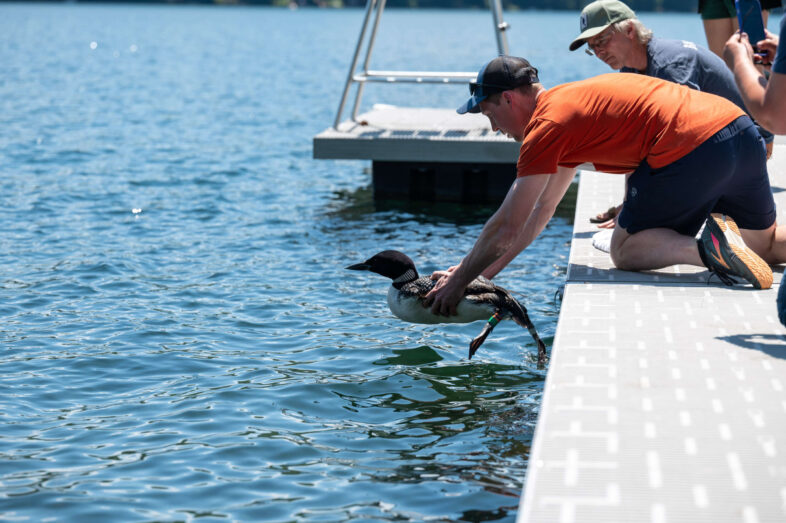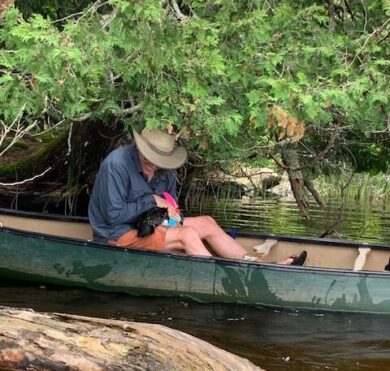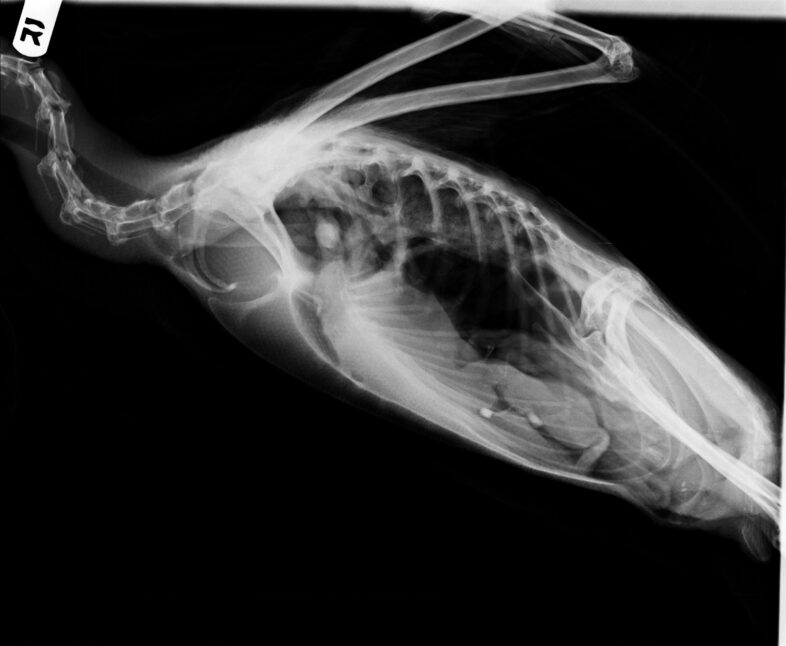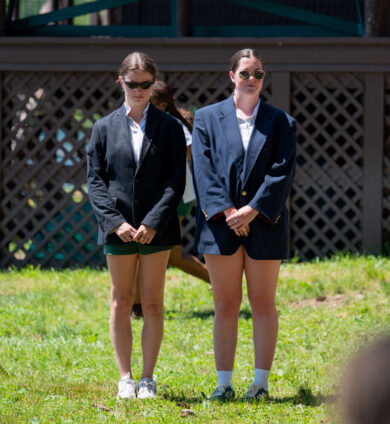
The rescued loon, dubbed “Madame President” by Camp Aloha, is released on Lake Morey. © Veronica Culhane
Nothing prepares you for your first close encounter with an injured loon. There is awe at its sheer size and stately plumage, concern for its plight, and caution for the very real danger posed by its substantial, knifelike bill.
On the summer solstice, these emotions and more coursed through our group of loon enthusiasts when we encountered a weak and exhausted Common Loon, resting in knee-deep water in the shade of an overhanging cedar tree. Here’s how it happened.
Before VCE Loon Biologist Eric Hanson and I bade farewell to new friends after a three-day trip in Vermont’s Northeast Kingdom, a few of us decided to dip our paddles in Forest Lake one last time. We’d spent a few days paddling three lakes, checking on loon nests, observing behavior for signs of courtship, conflict, and other loony drama. We’d discovered newly hatched chicks on nearby Little Averill Lake, just days old, riding on the back of the parent and tucking under its wing for protection. We’d constructed a new nesting platform, gaining a new level of respect for the volunteers who muscle these rafts in and out of their lakes each year. And we’d watched a territorial pair of loons on Forest Lake deal with an “intruder” loon.
There had been signs of loon-related trouble on Forest Lake for a few weeks. The established pair there did not lay eggs this year, and a third loon had been observed interacting with them during what should have been their nesting season. Disruption from an intruder can sometimes lead to conflict and displacement of one of the pair; but even if that does not happen, an intruder’s presence can cause enough consternation to prevent nesting.

VCE Loon Biologist Eric Hanson maintains a careful yet firm grip on the distressed loon on the way back to the dock. © Sandra Fary
So it happened that our small troupe, including an 18-year-old freshly launched from her high school graduation, a middle school science teacher attending the trip for professional development, and an 80-something adventurer who could hike and paddle circles around yours truly, came upon the distressed bird. Only a person with Eric’s depth of experience could discern whether intervention was necessary. Once he did, it also took his experienced hand to approach the loon as he did, grasping it carefully and firmly, (mostly) avoiding stabs while keeping the loon safe as we paddled back to the dock.
Whether this loon was a displaced member of the established pair or the intruder, we do not know. In fact, at the time we could not tell whether it was male or female, only that it might not survive without care.
Our colleagues at the Vermont Institute of Natural Science (VINS) welcomed us and the loon late on that hot Friday afternoon and immediately shifted into high gear to evaluate and treat the injured bird. Throughout the weekend, emails flew back and forth between Eric Hanson, Bren Lunberg (the VINS rehabilitator who oversees loon recovery), and Dr. Mark Pokras, a retired veterinarian from Tufts University who trains, advises, and provides invaluable expertise (as well as countless volunteer hours) to loon biologists across New England. They discussed the loon’s behavior, blood work, and x-rays.

The loon’s x-ray revealed some evidence of blunt trauma to the bird’s chest; however, the experts couldn’t identify any obvious injuries. © Provided by VINS staff
Although the images yielded no smoking guns, there were potential indications of blunt injury to the chest area, suggesting that the conflict with the other loons may have turned to violence at some point. Other causes of such injury could be a crash landing (such as landing on a surface other than water) or a boat collision.
The next significant finding was a high level of lead in the blood, but no obvious lead object in the x-ray. Had a sinker been ingested and then passed through the gizzard and GI tract? Lead sinkers weighing one-half ounce or less have been illegal in Vermont since 2007, but people still legally use larger lead sinkers and jigs, and many anglers still have lead tackle in their boxes. Notably, in the decade that followed Vermont’s lead tackle ban in 2007, we observed a three-fold decrease in loon mortalities from lead. But between 2019 and 2023, twelve loons have died from lead poisoning after ingesting fishing gear—a major increase. We don’t know why, but to try to stem the tide VCE teamed up with the Vermont Fish & Wildlife Department to launch the Vermont Fish Lead Free project. We have installed lead tackle (and fishing line) collection tubes at nearly 30 fishing access points statewide.
During the loon’s eleven days at VINS, rehabilitators performed a chelation process to remove lead from its bloodstream and began to feed it. The loon progressed from being force-fed fish, to fishing on its own (in a special tank “stocked” by VINS staff, to becoming aggressive when its human caretakers approached. These were all good signs, and after a week and a half the team agreed it was time for release.
Choosing a release site can be tricky. We would not want to release this loon to a new lake only for it to intrude upon another nesting pair or expose it (her, as it turns out) to another conflict. We sought a water body large enough that the loon could get some distance from a nesting pair or where no territorial pair was present. We also favored a contained water body (i.e., a lake rather than the Connecticut River), so that we could keep an eye on it in the days and weeks following its release. We found just the place not far from the VCE office.
Lake Morey is 547 acres in the town of Fairlee, Vermont. A pair of loons nested at the lake’s north end in each of the past two summers but did not nest this year. The lake is large enough that unpaired or transient loons sometimes congregate and socialize there, and these settings can be welcoming for single birds. There are also plenty of people on the lake to keep a watchful eye and report if the loon started to go downhill again.

Camp Aloha provided their own Secret Service detail for the release of “Madame President.” © Veronica Culhane
Lake Morey was an especially appealing choice to me because my daughter is a counselor at Camp Aloha there, and visiting the lake to release the loon could be a thinly veiled excuse for me to visit her as well. The Aloha team welcomed us eagerly as we gathered at the water’s edge on a blisteringly hot Tuesday afternoon. Bren brought the loon from VINS. Eric met us there, prepared to take feather samples and to color-band the loon so it could be easily identified and monitored from a distance. Bill and Sue Minard, our dedicated, local Loon Conservation Program volunteers, also joined us to observe the release. Aloha added some “camp magic” to the experience, dubbing our loon “Madam President,” providing their own Secret Service detail, and adding a note of importance to the celebratory fanfare. Eric gave a brief overview of the loon’s tale to more than 100 teenage women and their counselors, who then watched in rapt silence while the bird was banded and released from their dock. Madam President swam a few feet, preened, stretched her legs (no doubt wondering what her new plastic ankle jewelry was all about), hooted, and swam off. And you could have heard a pin drop. (Watch this momentous occasion.)
It was a moving moment that I still can’t recall without choking up–a conservation success that stands out among so many darker stories in this time.
This loon was in trouble, at least in part, because humans introduced lead into her environment. It was our duty to respond, but that response requires a village. What a village we have! In this case, it started with the owners of Quimby Resort, who watched the loons’ activity closely and responded when the early stages of conflict drove one loon out of the water and onto the adjacent road.
Three weeks later, as our group paddled Forest Lake, some other guests at Quimby noticed the distressed loon and told us about it (not knowing they were “reporting” to the statewide loon biologist!). They offered some education about loons, cautioning us to approach quietly and observe from a distance. Had they not pointed it out, we never would have happened upon the loon and its story would have ended very differently.
From there, many others played a role in the rescue: the staff and guests at Quimby who offered a towel, a box, and tape to prepare the loon for safe transport; the team at VINS that nursed the loon back to health; the veterinarian standing by for consultation at all hours; the staff and campers at Aloha Camp who welcomed us to their waterfront; and our Lake Morey loon project volunteers who have monitored loons on the lake for years, and continue to provide updates on Madam President. (She has been observed peacefully among a group of seven loons at the southwest corner of the lake, diving and behaving normally.) And you, dear VCE friends and dedicated conservationists, whose gifts of support to VCE and to VINS make our work possible. Thank you for being part of our village!

Her name is so timely!!
AWESOME ❤️👍
I could not love this story more – so nice to have a bright conservation highlight among some sad ones (including our Lake Iroquois) this summer. Wishing Madame President safe travels in her migration!